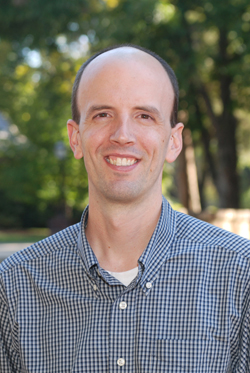 Damon SpaydeCONWAY, Ark. (May 1, 2011) – Dr. Damon Spayde recently received a three-year grant from the National Science Foundation (NSF) to support a research program in experimental nuclear physics at Hendrix College.
Damon SpaydeCONWAY, Ark. (May 1, 2011) – Dr. Damon Spayde recently received a three-year grant from the National Science Foundation (NSF) to support a research program in experimental nuclear physics at Hendrix College.
The award will allow Spayde, an Assistant Professor of Physics, and undergraduate student researchers to participate in a cutting-edge experiment looking for evidence of new physics processes by examining collisions between fast moving electrons and stationary protons.
The experiment is known as Qweak (http://www.jlab.org/qweak) and is a multinational collaborative effort involving over 100 Ph.D.-level physicists. It will take place at the Thomas Jefferson National Accelerator Facility, or Jefferson Lab, in Newport News, Va. (http://www.jlab.org).
This type of research is known within the field as "looking for physics beyond the Standard Model.” The Standard Model is the physical theory that explains the properties and interactions of subatomic particles (e.g. protons, electrons, neutrinos, etc.) and describes how all the matter in the Universe is put together
Hendrix students will analyze data from the experiment, write software used during the collection and analysis of data, and travel to Jefferson Lab to participate in the experiment. Additionally, Hendrix students will present the results of their research at national physics conferences and perform K-12 physics outreach projects at local schools or their alma mater.
Previous Hendrix students have worked on Qweak projects through the support of Your Hendrix Odyssey: Engaging in Active Learning. Those students designed and implemented a database that is used to store results from the experiment and some were at Jefferson Lab when the first electron-proton collisions were performed for Qweak. Current students will continue to maintain and extend that database, analyze the data stored in it, and pursue new projects as needed by the Qweak collaboration.
"This grant will enable several Hendrix students to work on extended research projects throughout the year,” Spayde said. “They will develop analytical and problem-solving skills that will benefit them no matter where life takes them. They will interact with a broader, multinational community of scientists through travel to Jefferson Lab and presentations at national physics conference”
“Perhaps most of all, they will get the confidence and satisfaction that comes from knowing they contributed in a significant way to an important and highly collaborative scientific endeavor,” he said. “I believe that an early research experience of this type will encourage a life-long love of science and inform their subsequent career choices."
Hendrix, founded in 1876, is a selective, residential, undergraduate liberal arts college emphasizing experiential learning in a demanding yet supportive environment. The college is featured in the 2010 edition of the Princeton Review as one of the country’s best 371 colleges, was identified as the nation’s top “Up and Coming” liberal arts college for 2011 by U.S. News and World Report, and is ranked among 45 “Best Buy” colleges by the 2011 Fiske Guide to Colleges. Hendrix has been affiliated with the United Methodist Church since 1884. For more information, visit www.hendrix.edu.